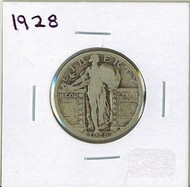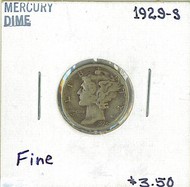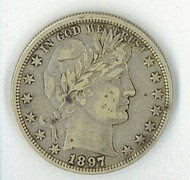In my last article I wrote about coin folders.
But most coin collectors also have coins in some sort of individual holders — especially the little cardboard ones with a plastic window in the middle. I think they’ve been using those for most of the last century!
The fact is, coin holders are one of the best ways to keep your coins safe.
No Coin Holder = Coin Damage
Without some sort of holder, your coins will shift around and slide over each other, bang into each other, and so on.
Over time, this causes so much wear that your coins will actually go down in grade (the amount of wear on the coin) and value! Uncirculated coins will become Circulated, and that is a very great loss indeed (often 1/2 to 2/3 of its value).
As a very sad proof of this, here is a picture of a coin I own which was “carefully” kept in a drawer lined with velvet along with many other coins for several decades.
What you may notice the most about it is not the amount of wear on it, but that the worn areas actually have a different color from the rest of the coin. While this is still a very nice Barber half dollar, it was once a far more beautiful one.
Facts About Cardboard Coin Holders
Cardboard coin holders usually come in two sizes: 1-1/2″ by 1-1/2″ or 2″ by 2″ (often referred to as 1.5×1.5 or 2×2’s). Size is the only real difference between the two, other than the fact that the smaller ones are too small to hold a dollar coin.
These holders come with ‘windows’ of many different sizes, for the different coins you might put in them. The most common sizes have holes just the right size for U.S. dimes, pennies, nickels, quarters, half-dollars and dollars (from small to large).
Old cardboard holders may not be made of very coin-friendly material in the long run — the cardboard may have acid in it, and the plastic may have PVC which will eventually cause it to shrink and turn yellow. If in doubt or you have a coin in a holder that is deteriorating, put it in a new holder.
I buy mine from a local coin shop for just 4 cents each (prices will vary by shop and manufacturer) — not a big investment for something that is so important and useful!
What To Write On Your Cardboard Coin Holders

Most collectors put some information about the coin in the holder on the front and/or back of the coin holder itself. This is convenient since the holder has a plain white surface on each side.
The information written on it is up to the owner, but usually has the coin’s date and mint mark at minimum.
 Sometimes they will also have the value of the coin or the owner’s asking price, the type of coin it is (“Mercury Dime” or just “Dime” for instance), and the grade of the coin (such as Good or Fine).
Sometimes they will also have the value of the coin or the owner’s asking price, the type of coin it is (“Mercury Dime” or just “Dime” for instance), and the grade of the coin (such as Good or Fine).
Here is an example with all four of these things written on it. Sometimes people put more private things on the back of the holder, such as the date bought or the price paid for the coin.
A Few Other Quick Notes About Coin Holders
- If you are putting coins in holders yourself, hold them by the edge so your fingers don’t smudge or put fingerprints on them. Use 2-4 staples (you’ll need a standard-sized stapler) — enough to keep the holder firmly closed at all edges.
- Remember that any information that is written on the holder by someone else is subjective — a grade written on a holder is someone’s opinion and may be different from yours, and a price written on a holder may not reflect what it is worth or what you would want to pay for it! This is why many people put grades and prices on the back of the holder or not at all.
- Several other options for individual holders exist; for example one of my local coin shops carries simple plastic holders for as little as 10 cents, or 20 to 50 cents for ones that are archival, which means they are safe for the coins and will not deteriorate over time. Since these have no writing surface, they usually offer a small pocket to put a piece of paper or cardboard in.
I hope your collecting has been enhanced by this information about the holders you see at your local coin shops and shows. Happy hunting!
I’ve been a coin collector and a rare book and collectible dealer for over 15 years. My primary areas of interest are U.S. silver coins and older paper currency.


